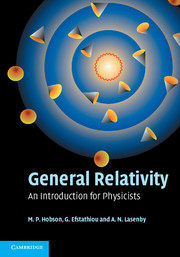Book contents
- Frontmatter
- Contents
- Preface
- 1 The spacetime of special relativity
- 2 Manifolds and coordinates
- 3 Vector calculus on manifolds
- 4 Tensor calculus on manifolds
- 5 Special relativity revisited
- 6 Electromagnetism
- 7 The equivalence principle and spacetime curvature
- 8 The gravitational field equations
- 9 The Schwarzschild geometry
- 10 Experimental tests of general relativity
- 11 Schwarzschild black holes
- 12 Further spherically symmetric geometries
- 13 The Kerr geometry
- 14 The Friedmann–Robertson–Walker geometry
- 15 Cosmological models
- 16 Inflationary cosmology
- 17 Linearised general relativity
- 18 Gravitational waves
- 19 A variational approach to general relativity
- Bibliography
- Index
4 - Tensor calculus on manifolds
Published online by Cambridge University Press: 05 September 2012
- Frontmatter
- Contents
- Preface
- 1 The spacetime of special relativity
- 2 Manifolds and coordinates
- 3 Vector calculus on manifolds
- 4 Tensor calculus on manifolds
- 5 Special relativity revisited
- 6 Electromagnetism
- 7 The equivalence principle and spacetime curvature
- 8 The gravitational field equations
- 9 The Schwarzschild geometry
- 10 Experimental tests of general relativity
- 11 Schwarzschild black holes
- 12 Further spherically symmetric geometries
- 13 The Kerr geometry
- 14 The Friedmann–Robertson–Walker geometry
- 15 Cosmological models
- 16 Inflationary cosmology
- 17 Linearised general relativity
- 18 Gravitational waves
- 19 A variational approach to general relativity
- Bibliography
- Index
Summary
The coordinates with which one labels points in a manifold are entirely arbitrary. For example, we could choose to parameterise the surface of a sphere in terms of the coordinates (θ, φ), taking any point as the north pole, or we could use any number of alternative coordinate systems. It is also clear, however, that our description of any physical processes occurring on the surface of the sphere should not depend on our chosen coordinate system. For example, at any point P on the surface one can say that, for example, the air temperature has a particular value or that the wind has a certain speed in a particular direction. These respectively scalar and vector physical quantities do not depend on which coordinates are used to label points in the surface. Thus in, order to describe these physical fields on the surface, we must formulate our equations in a way that is valid in all coordinate systems. We have already dealt with such a description for scalar and vector quantities on manifolds, but now we turn to the generalisation of these ideas to quantities that cannot be described as a scalar or a vector. This requires the introduction of the concept of tensors.
Tensor fields on manifolds
Let us begin by considering vector fields in a slightly different manner. Suppose we have some arbitrary vector field, defining a vector t at each point of a manifold.
- Type
- Chapter
- Information
- General RelativityAn Introduction for Physicists, pp. 92 - 110Publisher: Cambridge University PressPrint publication year: 2006

